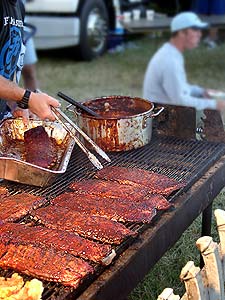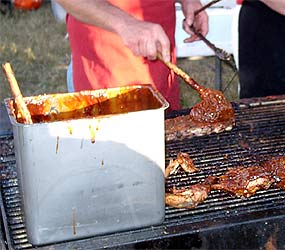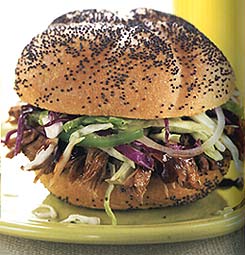by Dave DeWitt and Nancy Gerlach
 |
Memphis Baby Back Ribs Memphis Rib Rub Memphis-Style Finishing Sauce Kansas City Long Ends Kansas City Dry Rub Kansas City-Style Barbecue Sauce Carolina Pulled Pork Sandwiches with Coleslaw North Carolina Barbecue Sauce South Carolina Mustard Sauce Southern Hot Links Texas Beef Brisket New Mexico-Style Brisket Basting Sauce
|
Welcome to the Regional Barbecue Wars. For centuries now, the rival fractions have been firing off their best barbecue at each other, but at least they do it in fairly civilized manner: with rival pits at cook-offs big and small. The big battles are the East versus the West in North Carolina, but don’t forget about North Carolina pitted (ha, ha) against South Carolina. Georgia versus Alabama sounds like a football rivalry–and it is–but it also extends to BBQ. The biggest cook-off conflict has Memphis in May against the American Royal in Kansas City. And of course, there’s Texas versus Everyone Else. The minor skirmishes include beef versus pork, ribs versus brisket, pulled versus chopped pork, and mustard versus ketchup as a base for sauces. Whew. It’s downright contentious on all levels in the barbecue battles.
In the midst of all this conflict, a few food historians have noticed that there tends to be a common denominator in regional barbecue–the overwhelming tendency to use chile peppers to spice up the smoked meats. So traditional American regional barbecue is true fiery food, with chile peppers appearing in rubs, sops, marinades, and barbecue sauces from all over the country.
Despite the tradition of chiles in barbecue, our critics might complain that we have altered hallowed, sacred, and traditional regional recipes by spicing them up too much. To counter that charge, we reply that home cooks are not stupid. By reading the recipe first and noting the heat scale, the amount of chile in the recipe can easily be adjusted to taste.
We’d like to remind the cook that smoking meats is a very simple method of cooking and the variations are limited to the type of wood used as well as the different rubs, marinades, mops, and finishing sauces applied to the meat. So the basic technique of, say, smoking pork ribs, remains the same whether you’re in Memphis, Kansas City, or North Carolina. It is the flavorings added to the smoking process that make the difference, and if you want to use a Memphis rub with a Kansas City-style barbecue sauce, or a North Carolina sauce over brisket, be our guest.
Recipes:
This particular specialty can be smoked or smoke-grilled and it typifies the Memphis approach to cooking ribs–a double whammy of spices and sauce. As usual, watch for burning as the finishing sauce has a bit of sugar in the tomato. Why not serve these delicious ribs with traditional potato salad, cole slaw, and pickled peppers? Remember that the meat on smoked ribs looks pink, but that’s a chemical reaction with the smoke, and the ribs are really done. Really. It is difficult to take the temperature of the ribs because of the bones, so some instinctive cooking is required here.
-
1 cup Memphis Rib Rub, recipe below
-
3 slabs baby back ribs, about 4 pounds total
-
1 cup Memphis-Style Finishing Sauce, recipe below
In a large, shallow pan, pour the rub over the ribs and massage into the meat on both side. Cover and refrigerate for 4 hours. Remove the ribs from the refrigerator and bring to room temperature.
If smoke-grilling the ribs, build a fire that is 300 to 350 degrees F. Cook the ribs, covered, for 1 hour, turning often. Smoke-grill, basting the finishing sauce on the ribs with a brush, for another 30 minutes.
If smoking the ribs, maintain the smoke at 200 to 220 degrees F. and smoke for 2 hours. Brush the finishing sauce over the ribs several times during the last 1 hour of smoking, and turn the ribs occasionally.
Remove the ribs from the grill or smoker, and serve with additional finishing sauce on the side.
Yield: 4 servings
Heat Scale: Medium
This rub is great for smoking any cut of pork–ribs, chops, steaks, or even a roast. It has its origins in one of the barbecue centers of America, Memphis, Tennessee, home of the Memphis in May barbecue cook-off. You can also use rubs on grilled meats, so the next time you grill pork (or lamb) chops, try this rub.
-
1/4 cup paprika
-
2 tablespoons garlic salt
-
1 tablespoon freshly ground black pepper
-
2 tablespoons brown sugar
-
1 tablespoon onion powder
-
1 tablespoon dried oregano
-
1 tablespoon dry mustard
-
1 ½ teaspoons ground cayenne
Combine all ingredients in a bowl and mix well. Store any unused rub in a sealed container in the freezer.
Yield: approximately 2/3 cup
Heat Scale: Medium
|
|
Mopped on the job: Finishing ribs with sauce Photo by Harald Zoschke
|
This is the sauce that is traditionally served over smoked ribs in Memphis and other parts of Tennessee. Some cooks add prepared yellow mustard to the recipe. It can be converted into a basting sauce by adding more beer and a little more vinegar. Add more hot sauce to taste, or substitute red chile or cayenne powder.
-
1 cup tomato sauce, preferably freshly made
-
1 cup red wine vinegar
-
2 teaspoons Louisiana-style hot sauce
-
1 tablespoon butter
-
½ teaspoon freshly ground black pepper
-
½ teaspoon salt
-
½ cup light beer
Place all the ingredients in a saucepan and bring to a boil, stirring constantly. Reduce the heat and simmer, uncovered, for 15 minutes.
Remove from the heat, but serve warm over smoked meats.
Yield: 2 ½ cups
Heat Scale: Mild
Long ends are the lean, thin bones of spareribs, while short ends are the shorter, fatter, meatier hind sections. The combination of the rub and finishing sauce is traditional in Kansas City-style barbecue. The sauce is sometimes slathered over the ribs during the last half hour of smoking and is always served on the side. Why not serve these ribs with french fried, corn on the cob, spicy baked beans, and hot peach cobbler for dessert?
-
Kansas City Dry Rub, recipe below
-
6 to 8 pounds pork spare ribs, long ends only
-
Kansas City-Style Barbecue Sauce, recipe below
Place the rub in a shaker. Sprinkle evenly over the ribs and let them marinate for 2 hours at room temperature or overnight in the refrigerator.
Prepare a fire and place the ribs on racks in the smoker. Smoke with approximately 200 degree F. for 4 hours. If desired, baste with the sauce during the last ½ hour of smoking. Serve with the sauce on the side.
Yield: 4 to 6 servings
Heat Scale: Medium
From another center of the barbecue universe comes one of the dry rubs that made the Kansas City Royal cook-off such a highly competitive event. Try this rub on turkey and chicken too.
-
2 tablespoons brown sugar
-
2 tablespoons ground paprika
-
1 tablespoon white sugar
-
1 tablespoon garlic salt
-
1 tablespoon celery salt
-
1 tablespoon commercial chili powder
-
2 teaspoon freshly ground black pepper
-
1 teaspoon ground cayenne chile
-
½ teaspoon dry mustard
Combine all the ingredients in a bowl and mix well. Store any unused rub in a sealed container in the freezer.
Yield: 2/3 cup
Heat Scale: Medium
Kansas City-Style Barbecue Sauce
Here is the way sauce is made for the famous American Royal cook-off in Kansas City–or at least this is our take on the subject. It is truly a finishing sauce and should not be used as a marinade or a basting sauce. Of course, spread it liberally over ribs just off the grill and serve plenty on the side
-
1 small onion, chopped
-
2 cloves garlic, minced
-
1 tablespoon vegetable oil
-
1 cup catsup
-
1/3 cup molasses
-
1/4 cup distilled vinegar
-
2 tablespoons commercial chili powder
-
2 teaspoons dry mustard
-
1 teaspoon celery salt
-
1 teaspoon paprika
-
1 teaspoon ground cayenne chile
-
½ teaspoon freshly ground black pepper
-
1/4 cup water or more if needed
Saute the onion and garlic in the oil until the onions are soft. Add the remaining ingredients and simmer for ½ hour until thickened.
Yield:1 ½ cups
Heat Scale: Medium
Carolina Pulled Pork Sandwiches with Coleslaw
|
|
Carolina Pulled Pork Photo by Jeff Tucker and Kevin Hossler
|
Notice that we have not limited this recipe to the “southeastern corner of Western North Carolina,” but rather have made a universal Carolina recipe that you can sauce up with two or three styles of Carolina BBQ sauces. Even the coleslaw can go north or south. There is a minor debate about whether or not to use a rub, with purists generally preferring to salt the pork roast–a practice most smoking chefs don’t approve of. If you wish to use a rub, use the Memphis Rib Rub, p.00, which is quite similar to Carolina rubs.
Pulled Pork Sandwiches
-
3 to 4 pound Boston Butt pork roast
-
6 to 8 Kaiser rolls
-
Carolina Cole Slaw
-
3 cups shredded cabbage
-
1 small green bell pepper, thinly sliced
-
1/4 cup thinly sliced onion
-
Slaw Dressing
-
4 teaspoons sugar
-
1 tablespoon vegetable oil
-
3 tablespoons cider vinegar
-
1 teaspoon Dijon-style mustard
-
½ teaspoon celery seeds
-
Salt and freshly ground black pepper to taste
Sauce Choices
If using a rub, sprinkle it thickly over the roast and allow to sit, covered, at room temperature, for 3 hours. Start a fire and place the roast in the smoker on a rack. Place a drip pan beneath the grill as this roast will drip a lot of fat. Smoke the roast with 200 degree F. smoke for 4 or more hours, or until it is falling off the bone, or until the internal temperature reaches 170 degrees F.
Mix together the ingredients for the salad in a bowl. Combine all the ingredients for the dressing in another bowl. Pour the dressing over the salad and mix well. Cover and refrigerate for 2 hours.
Remove the roast from the smoker, transfer to a cutting board, and allow to sit for 20 minutes. With your fingers, remove any skin and fat from the roast. Pull the pork into thin pieces about an inch and a half long. This is slippery work and tedious, so if you get frustrated, take out a knife and chop the pork into ½ inch pieces. Then change the name of this recipe to Carolina Chopped Pork Sandwiches.
To serve, place the pork on the buns, spread the sauce of choice over the pork, and then add coleslaw to taste.
Yield: 6 to 8 servings
Heat Scale: Mild
This is the thin, vinegar sauce in the tradition of Eastern North Carolina. For a rough idea of the Western sauce, add 1 cup catsup, 1 teaspoon Worcestershire sauce, and ½ teaspoon of cinnamon to this recipe. This is served over smoked pork in any form–sliced or pulled.
-
2 cups cider vinegar
-
1/4 cup brown sugar
-
1 tablespoon crushed red pepper
-
3 teaspoons salt
-
1 ½ teaspoons ground cayenne chile
-
1 teaspoon freshly ground black pepper
-
1 teaspoon ground white pepper
Combine all the ingredients in a large bowl, mix well, and let stand for a couple hours to blend the flavors.
Yield: 2 cups
Heat Scale: Medium
In South Carolina, barbecue is flavored with mustard as a dominant ingredient rather than just an incidental spice. But vinegar makes its appearance here as well, plus some hot sauce. As in North Carolina, the sauce is primarily used over smoked pork. But you could serve this over grilled pork chops.
-
3/4 cup yellow “ballpark” mustard
-
3/4 cup cider vinegar
-
½ cup sugar
-
1 ½ tablespoons margarine
-
2 teaspoons salt
-
2 teaspoons Worcestershire sauce
-
1 1/4 teaspoons freshly ground black pepper
-
2 teaspoons Louisana-style hot sauce, or more to taste
Combine all the ingredients in a saucepan, stirring to blend, and simmer over a low heat for 30 minutes. Let stand at room temperature for 1 hour before using.
Yield: 1 3/4 cups
Heat Scale: Mild
Here is our recipe for a typically Southern sausage made with ground pork and lamb. For this recipe you will need a meat grinder with a sausage funnel, a tube that fits over the end of the grinder for filling sausage casings. You can also use a mixer such as KitchenAid, which has a sausage stuffer attachment. When stuffing, fill the casings until the sausage segments are about 4 inches long, then twist the casing and tie the sausages off with string. Then cut the casing off with scissors. Serve the links on buns with raw onions and barbecue sauce along with a macaroni salad and baked beans.
-
2 pounds ground pork, shoulder cut preferred
-
2 pound ground beef, round steak preferred
-
2 teaspoons crushed red chile (pequin for hot, New Mexican for mild)
-
2 teaspoons paprika
-
2 teaspoons dried sage
-
1 teaspoon ground cumin
-
2 teaspoons dried basil
-
1 teaspoon anise seed
-
2 teaspoons dried oregano
-
Sausage casings
-
Barbecue sauce of choice, such as North Carolina Barbecue Sauce, see above
In a bowl, combine all ingredients and mix well. Using a meat grinder with a stuffing attachment, stuff the sausage casings and tie them off. Build a fire in the smoker, place the sausages on the grill in the smoker, and smoke at 200 to 220 degrees F. for about 3 hours, or until the internal temperature reaches 170 degrees F. Remove from the smoker and serve with the barbecue sauce.
Yield: 10 servings
Heat Scale: Medium
Texas Beef Brisket New Mexico-Style
Okay, okay, we borrowed a Texas technique and changed the rub to reflect our chilehead tastes. For years we have been perfecting recipes using a smoker known as an Oklahoma Joe’s. It is a horizontal, cylindrical smoker about three and a half feet long and about fourteen inches in diameter. It has an attached, dropped fire box that allows smoking with fairly cool smoke because the fire is separated a bit from the smoking area. Because smoking is so time consuming, it makes sense to smoke several things at once. In addition to brisket, we also smoke a turkey breast. Some cooks use the basting sauce as a mop during the smoking process and eliminate the long marinade at the end of smoking. Leftovers, if there are any, make the best barbecue sandwiches when served on a crusty hard roll with your choice of sauce from chapter 3.
-
1 9 to 10 pound brisket (“packer trimmed” preferred)
-
½ cup lemon juice
-
2 cups mild red New Mexican chile powder
-
1 tablespoon ground cayenne chile
-
2 tablespoons freshly ground black pepper
-
1/4 cup garlic powder
-
Brisket Basting Sauce (recipe below)
Thoroughly coat all surfaces of the brisket with lemon juice, and rub in well. Combine the chile powder, cayenne, black pepper, and garlic powder in a bowl, and sprinkle generously all over the brisket, rubbing it in well. Make sure that the brisket is entirely covered. Allow to marinate for at least an hour before smoking.
To smoke the brisket, build a hardwood fire in the fire box using pecan, oak, or any fruit wood. When the fire is smoking nicely, place the brisket on the rack fat side up, to let gravity and nature do the basting. Place the breast as far from the heat source as possible, and close the smoker. During the smoking, do nothing to the brisket. The smoking will take approximately 8 hours at 200 degrees smoke temperature. This means a lot of beer will be consumed while you wait and tend the fire.
After the brisket has finished smoking, remove it from the smoker, slather it generously with Brisket Basting Sauce, wrap it tightly in aluminum foil, and return it to the smoker. Close off all of the air supplies to the fire, and allow the meat to “set” in the pit for about 2 hours.
Yield: A 10-pound brisket will yield about 10 to 20 servings, depending on the individual brisket and the size of the appetites of the guests.
Heat Scale: Medium
This recipe is from Red Caldwell, who revealed the secrets of Texas barbecue to us when we were editors of Chile Pepper magazine. After a beef brisket has been smoked, it is basted in this sauce for a couple of hours before it is sliced and served. Some cooks slather the sauce on during the smoking. It can also be used with smoked lamb or pork.
-
2 tablespoons commercial chili powder
-
½ teaspoon ground cayenne chile (or more to taste)
-
1 pound butter or margarine
-
2 onions, chopped fine
-
5 cloves garlic, minced
-
1 ½ cups beer, such as Shiner Bock
-
4 lemons, quartered
-
1 bunch parsley tops, minced
-
2 cups vegetable oil
-
1/4 cup Worcestershire sauce
-
2 bay leaves
In a pot, melt the butter, add the onions and garlic, and saute for 4 to 5 minutes to soften. Add the beer, squeeze in the lemon juice, and add the lemon rinds to the pot. When the foam subsides, add all of the remaining ingredients and bring to a boil. Reduce the heat to a medium low and simmer for 20 minutes.
Yield: About 5 cups
Heat Scale: Medium
Excerpt from Barbecue Inferno, (Ten Speed Press, 2001), and available from amazon.com






